Iron-dogging the Iditarod Trail:
Diary, days 7-10
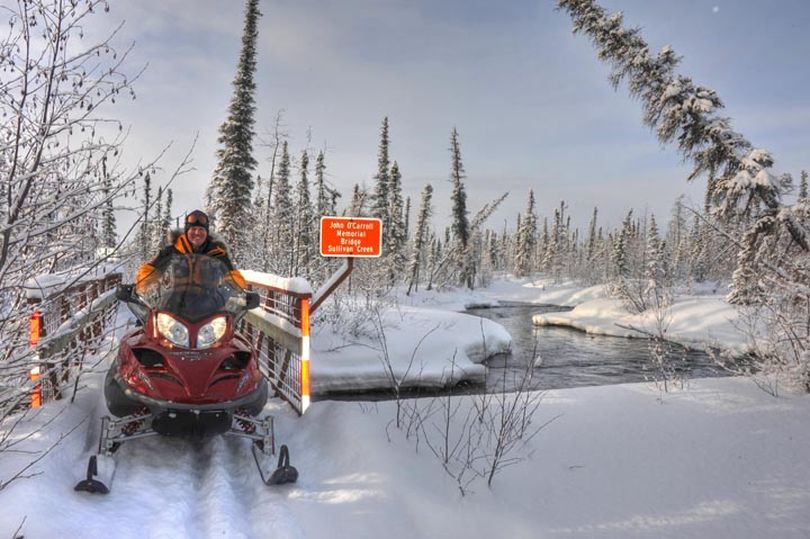
SNOWMOBILING -- As fate would have it, the real adventure began 70 miles from any assistance behind the racers in the Iditarod sled dog race. As the temperature plunged to minus 32 degrees -- nearly 60 degrees colder than the day they started out following the Iditarod Trail -- snowmobilers Bob Jones of Kettle Falls and Josh Rindal of Spokane faced some arctic cruelness:
- The starter on Bob's snowmobile was falling apart.
- A clunking noise was developing in Josh's snowmobile.
- A friend died in McGrath and the town had to unite to dig a grave in the frozen ground.
- Fuel was $7.15 a gallon in McGrath.
- Bob and Josh had to drive over a dead moose in the trail.
- And then Josh's snowmobile developed problems that threatened to end the 1,000-mile expedition.
Click "continue reading" to see how the two ingenious adventurers saved their butts by hooking on to something a fisherman left behind in a remote BLM cabin.
Also: click here to see a continuously updated photo gallery of the Iditarod Sled Dog Race.
Friday, March 9, 2012
Day 7. Zeroº, McGrath (Stephen’s house)
Cool and clear. This is more like it. A gorgeous spring day in McGrath.
Josh and I rode to Susie’s Airport Café for some coffee and some breakfast. We got there a little late for breakfast, so traded ham and eggs for a big, greasy cheeseburger with fries. Owners Todd and Susie were busy with all the Iditarod volunteers. The people from Rohn and Nicolai were stacked up waiting for flights out. So we got to see some of out pals again. The whole crew from Rohn was here. I bought Jasper Bond a burger as a part trade for the three sandwiches he fed us at that checkpoint
We finally found the first wireless since Skwentna, so I spent the better part of the afternoon catching up with the diary and photos and getting them e-mailed out.
I made arrangements to take our McGrath hosts and friends to a big steak dinner at McGuires Bar. If you want a steak at Iditarod time you better have a reservation. Todd and Susie cook huge rib-eye steaks on the back porch of McGuires Bar every Friday night of the year UNLESS the temperature is lower than -40º. The cooker can’t put out enough heat to cook meat at that temperature and below. They had a long session of -60º and lower this winter.
One thing I really find interesting about being out here in the villages along the trail is the subject of cold. I have NEVER heard mention of it in thirteen trips up the trail. People can’t do anything about it and it doesn’t concern them in the least. It is what ever it is. Around Kettle Falls the weather seems to be a constant worry. Up here, where there is real weather, no one seems to notice. When the temperature dips just put on more clothes. Not a problem……
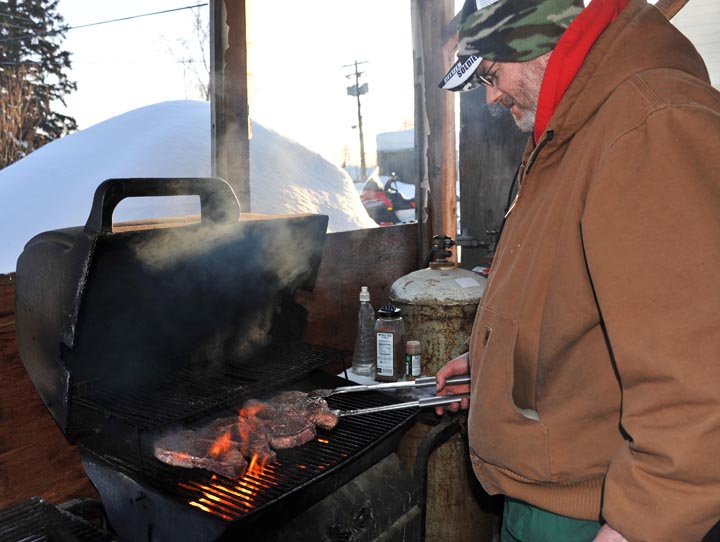
We all met at McGuires at 8pm for our steaks. I saw Dean Capaul of Northport earlier in the day and talked him into bringing his piano keyboard down to the bar. He set up and made us some great dinner music.
I always call the Friday night steaks the ‘Best Steak Served on a Paper Plate on Earth’ and Todd and Susie proved me right again. 20-oz rib steaks, huge baked spuds and a big lettuce salad made for a wonderful meal. There were seven of us and the cooker can only do four at time, so we ate in shifts and got into a few Miller Lites in between.
After dinner we went to Brett’s shop and looked over this years collection of wolf, lynx, wolverine and marten hides. Brett and Manzie have accounted for fifteen wolves so far this winter, and the best hunting is yet to come. The local moose herd appreciates their wolf reduction efforts, and is showing that appreciation by becoming much larger than it was prior to the elimination of some the big predators. Brett has spent a lifetime in the bush and is a top wolf hunter. He explained to us how a single wolf can kill a mature moose practically at will. The process consists of the wolf tearing enough tissue to get the moose bleeding, and then to continually harass that moose until it has become so weakened by the loss of that blood that it becomes fatal. He told us that a pack of wolves simply tears a moose to pieces and there is blood everywhere.
Story time in the shop lasted until after midnight when the beer was all gone. The boys of McGrath are a get-things-done bunch, and they have the real Alaskan bush stories to prove it.
We went back to Stephs under cold, clear skies, a nearly full moon, and a band of Northern Lights cutting a path across the horizon.
Saturday, March 10, 2012
Day 8. Minus 24º, McGrath
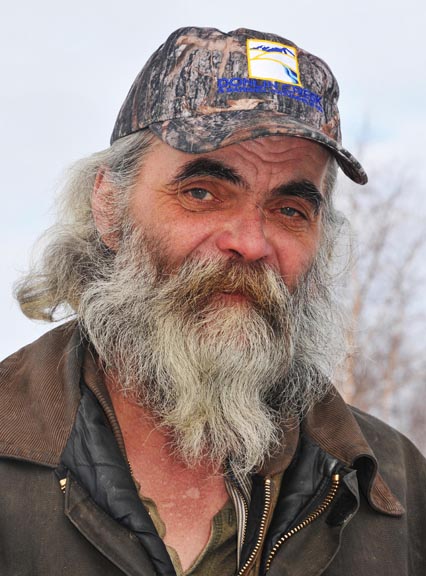
We got up at the crack of 9am (staying at the house of friend Stephen Strick), had breakfast, and made ready to ride our machines to town. The starter in my machine didn’t want to kick in, so Josh used the pull-start to get it running. We rode up in front of Susie’s Airport Café and took a look under the hood. There was a big 3-inch chunk of the starting flywheel broken out and laying in the engine compartment. Repairing it would take some parts from Anchorage and some real tools. But the rope-start worked fine. So we decided to go with the machine ‘as is’.
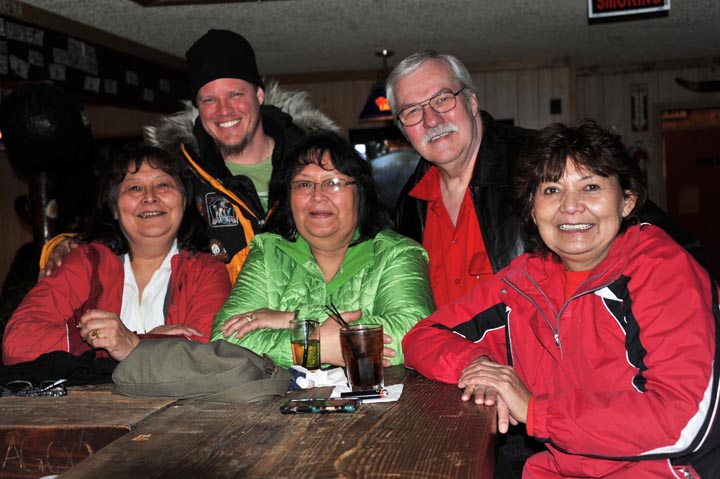
Our plan is to fuel up and to ride north as early as we can in the morning. There is a little shelter cabin at a place called Carlson’s Crossing of the Innoko River about eighty miles north of here, and that will be our destination for tomorrow night.
The Trail Sweeps finally got out of McGrath at 1:30pm, with the Carlson’s Crossing Cabin their destination for tonight. I told Bucko Norman to leave the cabin warmed up for us……
Susie’s Airport Café was winding down. Most of the Iditarod volunteers had flown out and moved on. Todd was going to only open from 9am to 3pm. But he let me stay and take advantage of coffee and the Internet.
We went to Steph’s for a great dinner and a long BS session. 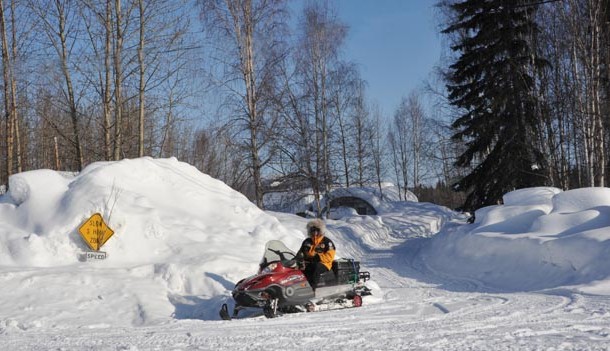 The consensus was that the broken electric start flywheel on my machine had to come off. The concern was the internal balance of the engine. So we went to the shop and Steph and Josh proceeded, after a couple of hours, to get that done. Fritz and I headed for the Roadhouse for a couple of beers. Steph and Josh called it a day.
The consensus was that the broken electric start flywheel on my machine had to come off. The concern was the internal balance of the engine. So we went to the shop and Steph and Josh proceeded, after a couple of hours, to get that done. Fritz and I headed for the Roadhouse for a couple of beers. Steph and Josh called it a day.
It was a clear, cold and gorgeous day in the great little village of McGrath. The boys have saved our bacon here on a regular basis over the past seventeen years. They are a great, hard working, back-to-the-fifties bunch and we love to spend time there.
Sunday, March 11, 2012
Day 9. -17º, McGrath
Clear and cold in McGrath.
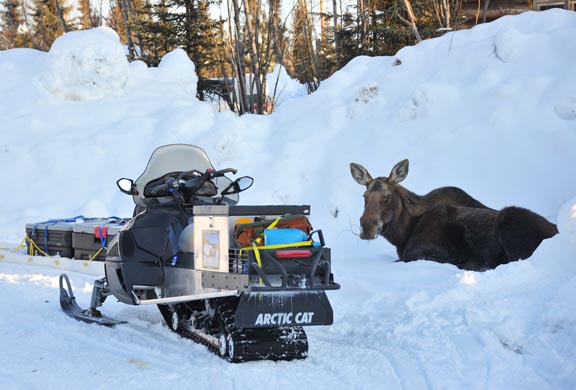
A quick look out the kitchen window revealed a big cow moose bedded down about six feet from my machine in the front yard this morning. We let her be until we were about ready to go. She got up and ambled down the road. The snow was too deep to easily maneuver in, so she didn’t.
Josh and I didn’t unpack much at Steph’s. Our cots had bedding on them. So it didn’t take long to get ready.
Richard Strict, Sr., Steph’s dad, had been battling leukemia for some time, and he gently passed away at his home in McGrath at 10:30am this morning. Fritz and Steph went to assist, and Josh and I made ready to head north. We had already said our goodbyes.
McGrath is a tight community, and everyone knows how to handle the passing of one of theirs in the bush. The boys had built a casket out of yellow pine and had it waiting in the shop. If you have ever attempted to dig a hole in frozen ground you understand how difficult it is. But here a concrete-like surface isn’t a consideration. Once the services are over, the friends and family, which is most of the 350 citizens of McGrath, will assemble at the cemetery with their picks and shovels. No backhoe will be used. It seemed to me that they have it right…. Dignity, friendship, and picks and shovels! “Let’s get ‘er done!”
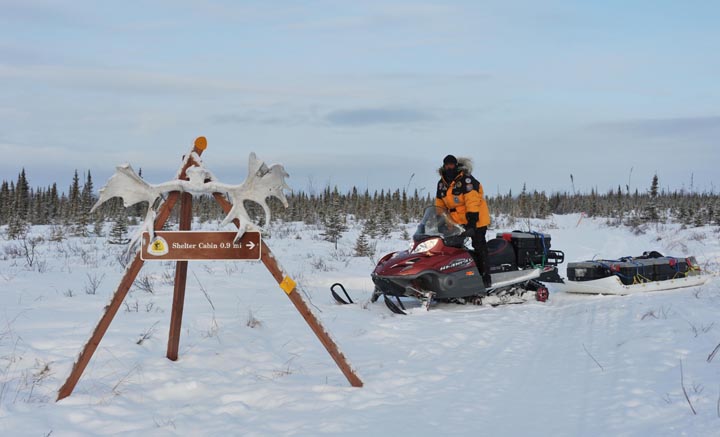
Fuel is $7.15 per gallon in McGrath this year, and Josh and I filled every container we could find, including a couple of discarded empty 1-gallon 2-cycle oil jugs, to the tune of two-hundred bucks worth, to insure that we had enough to make it the 200 miles across the North Route to Ruby. We got out at 1pm.
The day felt cold, for the first time this trip, as we rode out under clear skies. The eighteen miles to Takotna went by in an hour and twenty minutes. We stopped at the burn barrel in front of the check station and poured one 1-gallon 2-cycle oil jug of the fuel from McGrath in each machine. Takotna has no gas for sale.
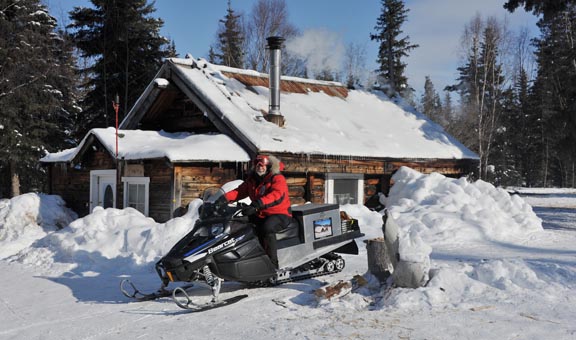
Our next stop was the log cabin checkpoint at Ophir. This checkpoint has been in continuous use since the original Iditarod No. 1 in 1973. That makes forty years. The cabin and grounds have been made available during that time as a courtesy of the Dick Forsgren family of Wasilla. In the early days it was a cabin used by the gold miners of the Ophir mining district. For the past 50 years it has been used as a headquarters for moose hunting on the Innoko River. At any rate, it is old, it is Alaskan, and it is very photogenic.
Keith Forsgren and his son were putting the final touches on putting the old cabin back into mothballs for the rest of the winter. They had two Super Cubs on skis waiting on the frozen Innoko River nearby, and they were making ready to return to their homes in Wasilla. Josh and I spent 45 minutes visiting with them.
The sun was still high in the sky at 5pm, thanks to the daylight savings time which began this morning. The extra light in the evening is welcome.
We rode up to the Carlson Shelter Cabin at 6pm sharp. My odometer showed 68.3 miles from McGrath with no detours. We had averaged about thirteen miles per hour.
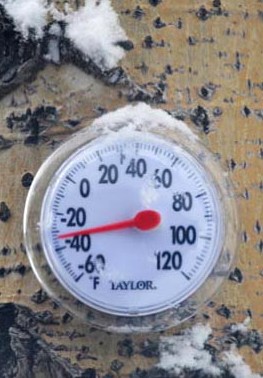
The thermometer on a tree next to the cabin read flat zero when we arrived. The Forsgrens reported minus forty for the past three nights as Ophir. The Cripple Checkpoint reported minus 46 just two nights ago. It is now 10pm as I write this, and the temperature reads minus ten.
Joshes machine developed a serious clunking sound somewhere around Ophir. And the speedometer quit. And the ‘check engine’ light came on. We un-hitched the tow sled from his machine and took it for a couple of short, high-speed runs hoping, perhaps, that it could be a piece of ice in the suspension. But that didn’t work. So we are wondering if we are going to have a machine in running condition all the way to Ruby. I plan to break out the satellite phone to call the Arctic Cat dealer in Wasilla when they open at 10am. A check of the engine oil and the water looks fine. But the noise had us a little worried....
The Carlson Crossing Shelter Cabin is a nice place to walk into when it’s zero outside. (BLM maintains four shelter cabins along the Iditarod Trail.) The barrel stove was still just a tiny-bit warm to the touch when we got here, and the cabin was far warmer than the outside air. I camped here two years ago and found the stove to be highly efficient. It can be closed down to keep the fire completely under control. That way the stove doesn’t burn much wood and the cabin doesn’t get too hot.
The shelter cabins along the trail all come equipped with journals so visitors can post their adventures along the trail, and the Carlson Crossing Safety Cabin is no exception. The introductory page is a “Welcome to ‘Beyondo’”, and states that it was built by the Boys of McGrath in 2009-2011 “In memory of our friend Richard Strick, jr. “ Richard lost his life to an avalanche near the summit of Rainy Pass while breaking the trail for the Iditarod Race a few years ago.
It was interesting to see that our pals, Fritz and Stephen, had been here on Friday the 9th. They had flown here, landed on the nearby river on skis, hiked to the cabin to check it out, and signed the journal. All at the same time we were at the Airport Café in McGrath. “Stopped by to check it out. Sweet cabin. Fritz Strick. 3-9-2012.” Later that night we all went to dinner.
11pm and the temperture has dropped to -15º. As I finish up this days diary the temperature inside the cabin is just warm enough to be perfect.
Monday, March 12, 2012
Day 10. -32º, Carlson’s Crossing BLM Shelter Cabin
WOW! Was this cabin nice last night! Especially when the thermometer read a little colder every time we checked it. At daylight it read -32º.
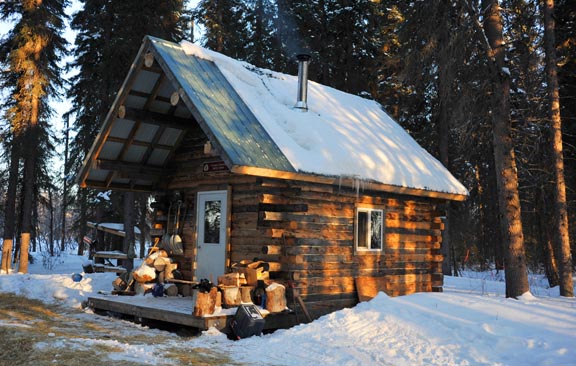
The Boys from McGrath like some creature comforts when they rough it, and they had a couple of electric lights strung in the cabin and a little 2000-watt Honda generator was in the corner. So Josh cranked it up and, lo and behold, we had lights! My two little LED lanterns were pretty dim by comparison.
We awoke to 32 degrees below zero and a cold, stiff world outside. Josh and I talked our situation over. His machine is the big question mark. Will it make it? Is the clicking sound terminal? It’s 70 miles back to McGrath and civilization. It’s 120 miles to Ruby and some relatively primitive conditions. Which direction do we go?
We packed up and I got on the sat phone right at the Wasilla Arctic Cat opening time of 10am. But, try as I may, I couldn’t get a connection. A recording kept saying that I’d dialed an incorrect number.
There was an emergency number on the telephone, and it didn’t work either. I tried a ‘super emergency’ and finally, after 6 voice prompts (I HATE phones!!!!!) I got a human. I explained to her that I was standing in minus 32-degree weather with a dead phone on my hands. She put me on hold. Finally after a few minutes she came back and told me to dial 00, then the number. It worked. My thoughts were that we should have been clued in with some paperwork to that effect when we got the phone.
The mechanic in Wasilla told me the speedometer failure and the check engine light probably weren’t a big deal.
Meanwhile, back at the shack: Josh finally, after many pulls, got my machine started. He wasn’t so lucky on his. We plugged the block heater into the generator and waited about a half hour. Finally, and very reluctantly, his 4-stroke fired up. We have 120 miles to ride today. We wanted to be on the trail by 10am. It is now 11:30am. We should be out of here by noon. We are going to head for Ruby and hope for the best with the mysterious clicking sound.
Ooooooops! When we were ready to ride out Joshes machine failed to start. No fuel pump. No headlight. So I called the mechanic back and told him to get here in a helicopter and his tools. We checked all the fuses, wires and everything else he could suggest to no avail. Now it was looking like we had a dead machine on our hands. Were we going to have to tow it back to McGrath and scratch from our trip??? It was looking like it.
Josh kept searching the wiring under the hood. Finally he disconnected the “O2 sensor to the exhaust manifold”, whatever the hell that is. He took it into the cabin and checked it out: A broken wire! One end was only about 1/16” long where it stuck out of a rubber plug. We couldn’t figure how to make the wire whole again. After some trial and error that didn’t work, we finally found a solution. There was an old spruce limb in the corner of the cabin that had a single Royal Coachman fly tied to some leader. We got the pliers out and, after straightening the hook, cut the barbed end off. That made a thin, sharp, electricity-conducting rod which we now forced into the short end of the wire and into the rubber plug. Then we took some electrical tape and wrapped the components up as tightly as we could. It looked pretty sanitary, and we thought it just might work. It was our only chance. So we took it back outside and plugged the wire back in. WOW! Did that headlight and the fuel pump working ever make our day! A half-inch piece of fish-hook resulted in our being able to continue to Nome. Without it we would have terminated our journey, somehow returned to McGrath, and come home from there. We finally got on the trail by mid-afternoon. But we were ON THE TRAIL!
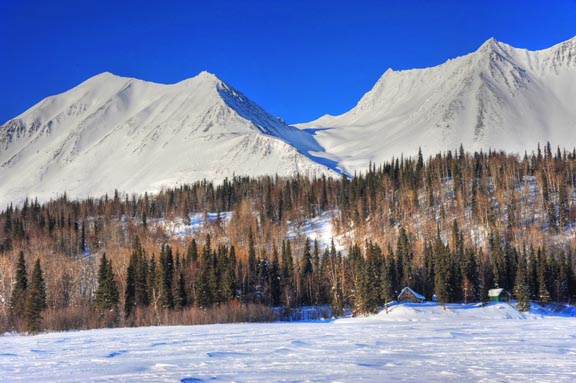
The trail was hard, flat and fast all day. The moguls weren’t too deep, and we could run at 15 to 20 mph most of the time. The trail north of McGrath was fantastic compared to the trail south of there.
By the way, the noise the mysterious clunking in Joshes machine mysteriously quit. Water under the bridge.
We came past the old Salatna River bridge. The gold fever hit hard in this country a hundred years ago, and great efforts were made to build a road out to the gold fields of the Ophir country. Sterling Landing and Takotna were on one end and Ruby was on the other. River access and sternwheelers made it relatively easy to get supplies into both areas: Sterling Landing on the Kuskokwim River and Ruby on the Yukon. From the Ruby end they decided to build the bridges first. But before the connecting roads were put in the money ran out. Hence, when you pass an overhead span steel bridge out in the middle of nowhere, you now have the reason. That’s the Salatna bridge.
The trail runs in a narrow, well-defined but heavily brushed-in path, for several miles on the Ruby side of the Salatna. It was in running in the lead down this path, and as I came around a corner I could see a moose lying in the trail 50 yards ahead. I was hoping she didn’t take offense to me and my machine and decide to do a little stomping exercise. She was a huge old cow and she was lying on her left side and she completely filled the trail. Luckily for us she was room temperature and frozen as hard as ice. I took a couple of photos and Josh asked me how we were going to get past. “Like this,” I told him. I got the tips of my skis up on the moose’s front legs and gunned the machine. I was towing the trailer and didn’t make it up and over on the first pass. The second try worked. It was about like running over a long pile of oil drums with hair.
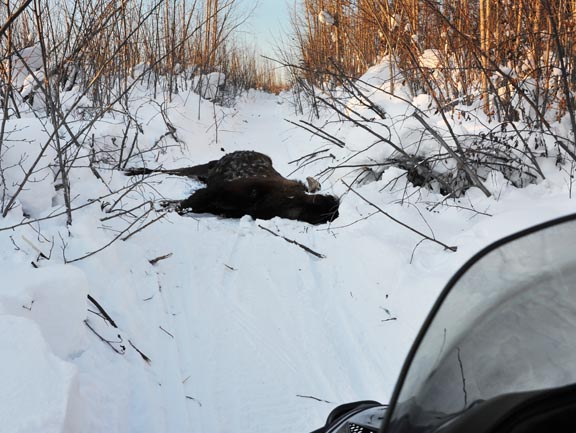
The moose’s demise would be anyone’s guess. There was no blood and no indication of a struggle with wolves. And the evidence didn’t show any significant traffic passing over the carcass. I thought it would be an odd position in which to starve to death. The snow in the country is DEEP, and many moose won’t be making it through this winter. As tough as the big Arctic deer are, they are almost no match for this one. Their trails show their lunging to move about. If I were to make a guess I would think, perhaps, that some musher at the end of the pack might have come across a belligerent cow moose who had staked her claim to the trail. She took an intense dislike to dogs. And the musher had a gun……….
We ran fast and steady but our late start was going to make for a late arrival in Ruby. We had a bed and breakfast waiting. It was looking like a 10pm arrival when Josh got one ski off the trail and fell into 4-feet of powder snow. It was up to his waist, with no bottom, just six inches to either side the little crust we were running on. I un-hooked the trailer and turned around, being very careful to keep my track up on the trail: I didn’t want to fall in too. Joshes machine was almost touching the trail, and after a couple of hard jerks he was back on top. That little delay put us into the little village and Iditarod Checkpoint of Ruby at 11pm.
It was very cold when we rode in. And I was surprised at the amount of snow and the depth of the snow around the village. This place was buried! People were climbing downhill to get into their houses. It took a while to find our host, Racheal, and her little guest cabin. But it was worth the ride. Our cabin was made of logs, was bright and clean, with two little single beds, and had an oil heater set to 72º. Perfect! AND wireless internet. Double Perfect!
Racheal had a fine dinner that she heated up for us and we both fell into our bunks at 1am. It had been a long day on the trail.
Tomorrow: 100 miles to go to Nulato - all on the Yukon River. And it's downstream!
Continue to Diary and photos for days 11-12.
Continue to Diary and photos for days 13-14.
Continue to Nome Sweet Nome: Diary and photos for Day 15.
Continue to Diary and photos for days 16-17.
Go back to Diary and photos, days 1-6.
